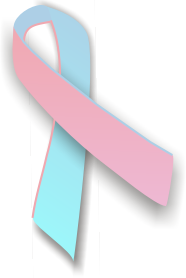
Back سرطان الثدي في الرجال Arabic Karcinom muške dojke BS סרטן השד בגברים HE 남성유방암 Korean Рак молочной железы у мужчин Russian Male breast cancer SIMPLE Rak dojke pri moškem Slovenian Ung thư vú nam Vietnamese 男性乳癌 Chinese
| Male breast cancer | |
|---|---|
 | |
| The pink and blue ribbon is used to signal awareness of male breast cancer. | |
| Specialty | Oncology |
Male breast cancer (MBC) is a cancer in males that originates in their breasts. Males account for less than 1% of new breast cancers with about 20,000 new cases being diagnosed worldwide every year.[1][2] Its incidence rates in males vs. females are, respectively, 0.4 and 66.7 per 100,000 person-years (person-years is the number of new cases divided by the product of the relevant population's size multiplied by the average number of years of observation, i.e. new cases ÷ [population × years]). The worldwide incidences of male as well as female breast cancers have been increasing over the last few decades.[3] Currently, one of every 800 men are estimated to develop this cancer during their lifetimes.[1]
Because it has a far lower incidence in males and because large-scale breast cancer studies have routinely excluded males, current knowledge of male breast cancer is far less than female breast cancer and often rests on small, retrospective, single-center studies.[4] Consequently, the majority of strategies for evaluating and treating MBC have been adopted from those used for female breast cancer.[5] However, MBC appears to have some features that warrant clinical approaches differing from those for female breast cancer.[4] Features of male breast cancers that differ from those in females include variations in their presentations, associations with other diseases, associations with non-medical predisposing conditions, expressions of key breast cancer-related hormones, causes (including frequency and forms of genetic alterations), tumor types, and treatments.[4]
- ^ a b Bray F, Ferlay J, Soerjomataram I, Siegel RL, Torre LA, Jemal A (November 2018). "Global cancer statistics 2018: GLOBOCAN estimates of incidence and mortality worldwide for 36 cancers in 185 countries". CA: A Cancer Journal for Clinicians. 68 (6): 394–424. doi:10.3322/caac.21492. PMID 30207593. S2CID 52188256.
- ^ Zattarin E, Ligorio F, Nichetti F, Bianchi G, Capri G, de Braud F (December 2021). "Prolonged benefit from palbociclib plus letrozole in heavily pretreated advanced male breast cancer: case report". Tumori. 107 (6): NP15 – NP19. doi:10.1177/0300891620976981. PMID 33297845. S2CID 228089361.
- ^ Benassai G, Miletti A, Calemma F, Furino E, De Palma GD, Quarto G (2020). "Male breast cancer: an update". Annali Italiani di Chirurgia. 91: 359–365. PMID 33055389.
- ^ a b c Zheng G, Leone JP (2022). "Male Breast Cancer: An Updated Review of Epidemiology, Clinicopathology, and Treatment". Journal of Oncology. 2022: 1734049. doi:10.1155/2022/1734049. PMC 9155932. PMID 35656339.
- ^ Khan NA, Tirona M (March 2021). "An updated review of epidemiology, risk factors, and management of male breast cancer". Medical Oncology (Northwood, London, England). 38 (4): 39. doi:10.1007/s12032-021-01486-x. PMID 33721121. S2CID 232237548.